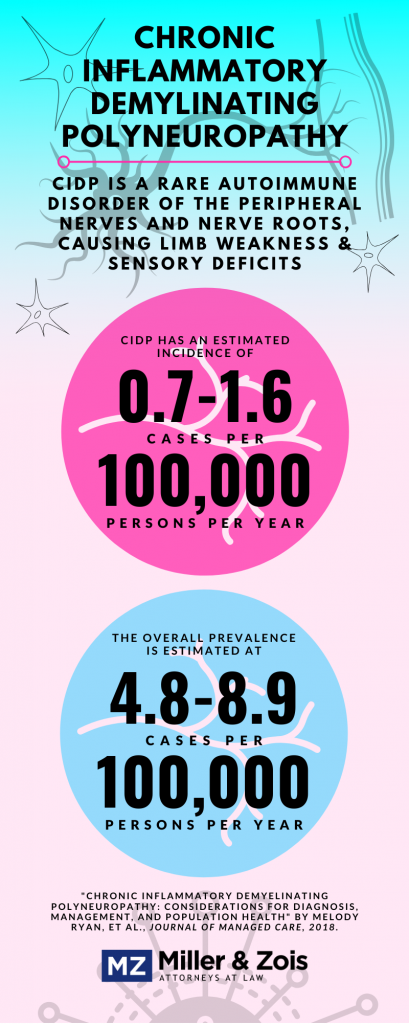Chronic inflammatory demyelinating polyradiculoneuropathy (CIDP) is an uncommon neurologic condition causing impairment of the arms and legs. CIDP is a condition that is frequently misdiagnosed leading to harmful delays in treatment or unnecessary treatments. If you have been harmed by a misdiagnosis of CIDP you may be entitled to bring a malpractice case and get compensation.
What is CIDP?
Chronic inflammatory demyelinating polyradiculoneuropathy (CIDP) is a disorder in which the immune system attacks the fatty myelin sheaths that protect and insulate nerves. This eventually causes weakness, impairment and/or paralysis in the arms and legs. It can also cause sensory impairments.
The motor and sensory impairments typically occur on both sides of the body and the degree of severity varies in individual cases. Some affected individuals may follow a slow steady pattern of symptoms while others may have symptoms that get better than get worse suddenly. Early treatment is very important in treating CIPD.
CIDP is related to a more common condition called Guillain-Barré syndrome (GBS). Both CIDP and GBS involve the same neurologic limb impairment. However, GBS is an acute condition that occurs very suddenly and then goes away after a few weeks. By contrast, CIDP is a more progressive disorder and it does not resolve on its own without ongoing medical treatment.
What Are the Symptoms of CIPD?
The initial symptoms of CIDP are unexplained weakness in the limbs (arms and legs). This is often accompanied by sensory issues such as abnormal and persistent tingling or numbness in the hands and feet. As the condition progresses, the weakness in the arm and legs gets worse and the individual begins to lose full control of the limbs. Eventually, the individual will have some level of motor impairment or paralysis in the limbs.
What Causes CIPD?
The exact cause of CIDP is not fully understood. However, CIDP is an autoimmune disorder that occurs when the body’s own natural defenses (antibodies and lymphocytes) that normally protect against invading organisms suddenly begin to attack perfectly healthy tissue inside the body instead. It is not known why autoimmune disorders happen in certain people.
How Is CIDP Diagnosed?
CIDP is diagnosed through the identification of physical symptoms consistent with the condition. If your doctor suspects CIDP, there are a variety of diagnostics tests available to help confirm the diagnosis. A nerve conduction (electromyography or EMG) study can be done to identify signs of damage to the myelin coating on nerves. This test uses low electric currents to test nerve functioning. A lumbar puncture can also be used to help diagnose CIDP. In this procedure, a small needle is inserted into your back to extract a sample of cerebrospinal fluid (CSF). CSF is the fluid that surrounds your spinal cord. The CSF sample is examined to look for elevated levels of certain proteins related to the disease.
Can CIDP Be Treated?
CIDP is a treatable condition. About 80% of people with CIDP can be effectively treated. As with all autoimmune conditions, the treatment of CIDP involves medications that suppress the individual’s immune system. Intravenous Immunoglobulin infusions (IVIg) are also another form of treatment for CIDP. Unfortunately, the treatments for CIDP have a number of very serious side effects and risk.
Is There Misdiagnosis of CIDP?
A recent study found that many people are improperly diagnosed with CIDP when then don’t actually have the condition. According to the study, at least 50% of patients who are diagnosed with CIDP do not really have the condition. They either have a different neurologic or no condition at all. This can be very harmful because the treatments for CIDP can not only be very expensive, but they also have significant negative impacts on an individual’s health. Sometimes, the treatments for CIDP can cause permanent injury or death.
The high rate of misdiagnosis of CIDP is attributed to a number of factors. One of the problems is that doctors tend to rely too heavily on the presence of elevated proteins in the spinal fluid to make a CIDP diagnosis. This is particularly true when electromyogram study results are not conclusive. Too often a doctor will make a diagnosis of CIDP based on proteins in the spinal fluid even though the nerve study results do not support it. A proper CIDP diagnosis should be confirmed by both proteins in the CSF and at least some indication of potential myelin damage on the nerve conduction test.
Medical Malpractice Based on Misdiagnosis of CIDP
If you were misdiagnosed with CIDP because the doctor failed to follow proper CIDP diagnostic protocol, you may be entitled to compensation for physical harm that you suffered as a result of this diagnosis. If you were incorrectly diagnosed with CIDP and suffered painful and/or harmful side effects or complications from the resulting treatment, we can hold the doctor liable for those injuries. Call our medical malpractice lawyers today for a free consultation at 800-553-8082.
 Maryland Injury Law Center
Maryland Injury Law Center


